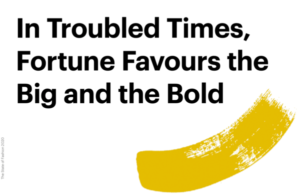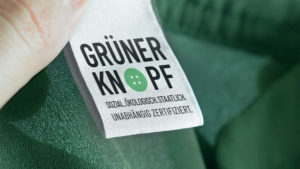McKinsey and BoF’s yearly State of Fashion report just launched their 2020 edition. But maybe launching a 108 page report the week before Black Friday was not the best strategy for getting industry folks to read it.
Fear not.
While the entire Adore Me team was surviving and thriving over the Black Friday rush, I read it for you, and a large part of the report covers sustainability. As an early holiday present, I’ll provide you with a summary.
This edition is quite dense with information, so I’ve organized it into five themes:
- Statistics: a quick roundup of stats
- Consumer Education: the important role of the consumer
- Organizational: the business school-ish stuff
- Upcycling: the lowest-hanging fruit
- Materials Revolution: If you want to skip ahead, this is where we cover crazy things like squid-gene inspired fibers.
Happy Reading,
Ranjan
One quick note to start: the report is not a positive one for the industry. Quite literally. The report is titled “Navigating Uncertainty” and it starts with the words, “Fashion leaders are not looking forward to 2020.”
Trade wars, political uncertainty, combined with continued rapid consumer and technological shifts, mean things will be, at best, risky.

But the report is also clear, amidst the uncertainty is when the next generation of winners will be established. The companies making the right investments and decisions in the projected downturn will be the ones best positioned to win when things are once again good.
And highly relevant to this newsletter, they wrote:
For the first time, sustainability topped the list of the biggest challenges facing the industry, and it was also named the biggest opportunity
Sustainability is both the biggest challenge and also the biggest opportunity.
That seems like a good place to start.
1) STATISTICS
We love numbers and this report is full of them. I’ve curated a few sustainability-themed stats to use to impress your friends or scare your family:
- Fashion produces 53 million tons of fiber, 70% of which ends up in landfills or incinerated.
- 66% of consumers (including 75% of millennials) consider sustainability when buying luxury…
- ….but only 31% of Gen Z and 12% of baby boomers would spend more for sustainability (ok, boomer).
- There has been a 5x increase the use of sustainable materials in the past 2 years
- The smart-textile market will grow from currently $93 billion to $475 billion in 2025
A few industry pledges to note:
- Zara will use 100% sustainable fabrics by 2025
- H&M will use 100% recycled or sustainable materials by 2030
- Adidas will phase out virgin polyester by 2024
2) CONSUMER EDUCATION
Consider 2019 the end of the green-washing era.
First, read this incredible quote (p. 53):
Nothing is black and white, unfortunately… It’s huge shades of green, really. That makes it very difficult because it lends itself very easily to greenwashing and misunderstanding… that can be quite confusing for the consumer”- Nina Marenzi, founder and director of The Sustainable Angle
And follow it up with (p.16):
Despite some modest progress, fashion hasn’t yet taken its environmental responsibilities seriously enough. Next year, fashion players need to swap platitudes and promotional noise for meaningful action and regulatory compliance while facing up to consumer demand for transformational change.
If a brand says they “are sustainable”, consumers still have very little idea of what that means. But McKinsey predicts 2020 will be the year where the fashion media, governments and brands themselves start to educate consumers and create more formal definitions.
One example is the “Green Button” (Gruner Knopf), a recent initiative from the German government that attempts to certify manufacturers who meet a baseline of sustainability requirements.

3) ORGANIZATIONAL
This is the business school-y part.
Companies will increasingly approach sustainability efforts in one of three ways. The first is via strategic partnerships (p. 63):
We expect over the coming year to see more collaboration between start-ups, fibre companies, manufacturers, fashion brands and retailers. Rather than single products or special lines, these innovations may increasingly play out across a company’s wider activities.
This is very much in line with McKinsey’s recent report on sustainable sourcing in fashion, where they argue that brands need to turn suppliers into strategic partners.
Next, they anticipate many of these partnerships could evolve into increased vertical integration. As Marenzi (who gave us the green-washing quote above) put it (p. 54):
“It is very complex [but] having a much more vertical, integrated supply chain approach [means] you are in full control of your materials; the more vertical you are, the more you can mitigate […] your impact on the oceans and climate and biodiversity.”
Vertical integration also provides potential cost advantages, which brings us to the third theme: continued business model innovation pertaining to sustainability.
McKinsey’s 2019 edition actually predicted “The End of Ownership”, i.e. rental models, as a major theme. They got that right, and argue rentals will continue to rise in importance, but remain an overall small share of the market. The report also indicates that circular economy efforts will become central to new business models.
4) UPCYCLING
Fabric waste costs everyone in the supply chain money. What if we could use fabric waste to create new garments? It’s the veritable win-win-win (manufacturer-brand-customer) and the report argues this is the most logical place to start from.
It outlines some initiatives, like Patagonia’s ReCrafted line, that make new items out of old garments. It then focuses on how Eileen Fisher and Adidas stress the importance of creating garments that can be more easily recycled at the end of their first life.
But as upcycling garments is an incredibly difficult task, fabric waste is the best place to start to make an immediate impact. They tell us to expect many more initiatives in this space in 2020.
Two great quotes from the section were (p. 57)
“Throwing stuff away in a landfill, you’re also throwing away money.” – Jonathan Taylor
“You just have to disconnect from a preconception of an existing supply chain model and really think creatively around what’s happening.“ – Graeme Raeburn
5) MATERIALS REVOLUTION
This is the fun section.
The report had an entire section on the upcoming ’Materials Revolution’, i.e. innovation in fibers and fabrics.
Let’s start with a few stats:
- Companies around the world are set to file 8 times as many fibre innovation patent applications in 2019 as they did in 2013
- 67 percent of sourcing executives state that the use of innovative sustainable materials will be important for their company
- 45 percent of apparel companies surveyed by McKinsey are looking to integrate more innovative bio-based materials
Now, let’s get to the really fun part.
According to click data, readers of this newsletter love reading articles that introduce us to crazy things like “kelp-based yarn” or “mushroom-leather.”
The report was chock full of these and I’ve listed as many examples as I could:
- New Balance, VF Corporation and 3M are experimenting with leather alternatives such as Piñatex, which is made of pineapple leaf fibres.
- Acabada ProActiveWear and Devan Chemicals are partnering to create products from hemp, which requires less water and fewer chemicals than cotton.
- Evolved By Nature, which is working on creating sustainable silk 😀
- Japan’s Xenoma has gone a step further, developing “e-skin” that monitors fitness and health with Printed Circuit Fabric (PCF) technology.
- Google in September 2019 released its Cit-e backpack in collaboration with Saint Laurent.
There is also a corresponding section on Fashion’s Biological Revolution, or innovation made possible by advances by DNA sequencing and new molecular technologies.
If you thought pineapple leather was cool, imagine squid-gene fabric that doesn’t shed micro-plastics.
- Silk from Fermentation: Bolt Threads, Germany’s AM Silk and Japanese textile research company Spiber have used fermentation techniques to engineer artificial silk proteins and fiber.
- Thread from Methane: California-based Genomatica and Mango Materials have engineered microbes to ferment renewable feedstocks and methane gas into biopolymers. The latter uses waste methane to produce PHA, a polymer that is then spun into thread
- Thread from Microbe digestion: Ambercycle has genetically engineered microbes to digest polymers from old textiles and convert them into polymers that can be spun into yarns.
- Leather from Collagen: Modern Meadow developed Zoa, a biological, lab-originated alternative to leather made from collagen protein.
- Dye from Bacteria: Faber Futures lab-engineered pigment producing bacteria (“coelicolor”) from which textiles take on rich blue, purple and red tones depending on the pH of the environment.
- Dye from Algae DNA: Algalife is doing similar work to engineer the DNA of algae to develop pigments and combat pollution caused by dyeing processes.
- A Bacteria Suit: A collaboration between MIT Media Lab and New Balance has made live bacteria that naturally react to moisture and produce a breathable “second skin” suit.
- Squid Gene Fiber!!!: Tandem Repeat is producing fibre based on squid genes. The genetic code in the material is focused on healing, enabling garments to repair themselves. The material also acts as glue, which minimises microfibres shredding during washing and reduces the flow of microplastics into the oceans.
If anyone made it this far, thank you for reading and, if interested, you can check out all my notes from the larger report (covering changes in marketing and physical retail).






